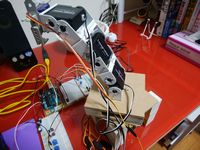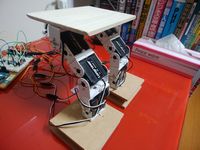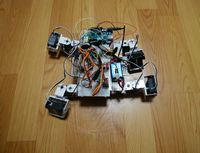画像内の「犬猫の品種」を検出するトレーニングをローカルで行う [Object Detection API]
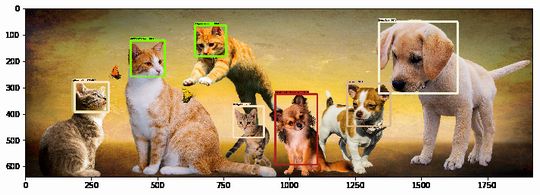
TensorFlowのObject Detection APIの2番目のクイックスタートである
| Distributed Training on the Oxford-IIIT Pets Dataset on Google Cloud Google CloudでOxford-IIITペットデータセットの分散トレーニング |
を行います。ただし、Google Cloudは使用せずにローカルのGPUでモデルのトレーニングを行います。リンク先は英語ですが、出来る限り日本語で解説していきます。
前提条件
| 画像内の物体を検出するObject Detection APIの使用方法 |
の続きとなります。事前準備がありますので先にご覧ください。
※TensorFlow Modelsのインストール先は「/root/models」です。
1. 共有フォルダに専用フォルダを作成する
ホストOSとコンテナの「共有フォルダ」は次のようになっています。
/home/ユーザー名/tensor
[コンテナ側]
/foo
今回は/fooに「pets」フォルダを作成して使用します。
※コンテナ上の/fooは、実質的に/home/ユーザー名/tensorと同じです。
2. Oxford-IIITペットデータセットのダウンロード
cd /foo/pets wget http://www.robots.ox.ac.uk/~vgg/data/pets/data/images.tar.gz wget http://www.robots.ox.ac.uk/~vgg/data/pets/data/annotations.tar.gz tar -xvf images.tar.gz tar -xvf annotations.tar.gz
3. TFRecordファイルを作成する
Oxford-IIITペットデータセットのimagesとannotationsからTFRecordファイルを作成します。
cd /root/models/research/
export PYTHONPATH=$PYTHONPATH:`pwd`:`pwd`/slim
python object_detection/dataset_tools/create_pet_tf_record.py \
--label_map_path=object_detection/data/pet_label_map.pbtxt \
--data_dir=/foo/pets \
--output_dir=/foo/pets
※このスクリプトを実行する際には、いくつかの警告が表示されます。
次にpet_label_map.pbtxtファイルをコピーしておきます。
cp object_detection/data/pet_label_map.pbtxt /foo/pets/pet_label_map.pbtxt
4. COCOの事前学習モデルをダウンロードする
cd /foo/pets wget http://storage.googleapis.com/download.tensorflow.org/models/object_detection/faster_rcnn_resnet101_coco_11_06_2017.tar.gz
次にUbuntu側のユーザーで「/foo/pets/faster_rcnn_resnet101_coco_11_06_2017.tar.gz」を右クリックして「ここで展開する」を選択します。
そして、その「faster_rcnn_resnet101_coco_11_06_2017」フォルダにあるファイルを「/foo/pets」に移動します。その後、空の「faster_rcnn_resnet101_coco_11_06_2017」フォルダを削除します。
ここで/foo/petsのファイル構成は次のようになります。
[フォルダ] annotations images [圧縮ファイル] annotations.tar.gz faster_rcnn_resnet101_coco_11_06_2017.tar.gz images.tar.gz [ファイル] frozen_inference_graph.pb graph.pbtxt model.ckpt.data-00000-of-00001 model.ckpt.index model.ckpt.meta pet_faces_train.record-00000-of-00010 pet_faces_train.record-00001-of-00010 pet_faces_train.record-00002-of-00010 pet_faces_train.record-00003-of-00010 pet_faces_train.record-00004-of-00010 pet_faces_train.record-00005-of-00010 pet_faces_train.record-00006-of-00010 pet_faces_train.record-00007-of-00010 pet_faces_train.record-00008-of-00010 pet_faces_train.record-00009-of-00010 pet_faces_val.record-00000-of-00010 pet_faces_val.record-00001-of-00010 pet_faces_val.record-00002-of-00010 pet_faces_val.record-00003-of-00010 pet_faces_val.record-00004-of-00010 pet_faces_val.record-00005-of-00010 pet_faces_val.record-00006-of-00010 pet_faces_val.record-00007-of-00010 pet_faces_val.record-00008-of-00010 pet_faces_val.record-00009-of-00010 pet_label_map.pbtxt
5. Configファイルの設定
ファイルをコピーして文字列を置換します。
cp /root/models/research/object_detection/samples/configs/faster_rcnn_resnet101_pets.config /foo/pets/faster_rcnn_resnet101_pets.config sed -i "s|PATH_TO_BE_CONFIGURED|/foo/pets|g" faster_rcnn_resnet101_pets.config
ファイルの中身は次のようになります。
[faster_rcnn_resnet101_pets.config]
# Faster R-CNN with Resnet-101 (v1) configured for the Oxford-IIIT Pet Dataset.
# Users should configure the fine_tune_checkpoint field in the train config as
# well as the label_map_path and input_path fields in the train_input_reader and
# eval_input_reader. Search for "/foo/pets" to find the fields that
# should be configured.
model {
faster_rcnn {
num_classes: 37
image_resizer {
keep_aspect_ratio_resizer {
min_dimension: 600
max_dimension: 1024
}
}
feature_extractor {
type: 'faster_rcnn_resnet101'
first_stage_features_stride: 16
}
first_stage_anchor_generator {
grid_anchor_generator {
scales: [0.25, 0.5, 1.0, 2.0]
aspect_ratios: [0.5, 1.0, 2.0]
height_stride: 16
width_stride: 16
}
}
first_stage_box_predictor_conv_hyperparams {
op: CONV
regularizer {
l2_regularizer {
weight: 0.0
}
}
initializer {
truncated_normal_initializer {
stddev: 0.01
}
}
}
first_stage_nms_score_threshold: 0.0
first_stage_nms_iou_threshold: 0.7
first_stage_max_proposals: 300
first_stage_localization_loss_weight: 2.0
first_stage_objectness_loss_weight: 1.0
initial_crop_size: 14
maxpool_kernel_size: 2
maxpool_stride: 2
second_stage_box_predictor {
mask_rcnn_box_predictor {
use_dropout: false
dropout_keep_probability: 1.0
fc_hyperparams {
op: FC
regularizer {
l2_regularizer {
weight: 0.0
}
}
initializer {
variance_scaling_initializer {
factor: 1.0
uniform: true
mode: FAN_AVG
}
}
}
}
}
second_stage_post_processing {
batch_non_max_suppression {
score_threshold: 0.0
iou_threshold: 0.6
max_detections_per_class: 100
max_total_detections: 300
}
score_converter: SOFTMAX
}
second_stage_localization_loss_weight: 2.0
second_stage_classification_loss_weight: 1.0
}
}
train_config: {
batch_size: 1
optimizer {
momentum_optimizer: {
learning_rate: {
manual_step_learning_rate {
initial_learning_rate: 0.0003
schedule {
step: 900000
learning_rate: .00003
}
schedule {
step: 1200000
learning_rate: .000003
}
}
}
momentum_optimizer_value: 0.9
}
use_moving_average: false
}
gradient_clipping_by_norm: 10.0
fine_tune_checkpoint: "/foo/pets/model.ckpt"
from_detection_checkpoint: true
load_all_detection_checkpoint_vars: true
# Note: The below line limits the training process to 200K steps, which we
# empirically found to be sufficient enough to train the pets dataset. This
# effectively bypasses the learning rate schedule (the learning rate will
# never decay). Remove the below line to train indefinitely.
num_steps: 200000
data_augmentation_options {
random_horizontal_flip {
}
}
}
train_input_reader: {
tf_record_input_reader {
input_path: "/foo/pets/pet_faces_train.record-?????-of-00010"
}
label_map_path: "/foo/pets/pet_label_map.pbtxt"
}
eval_config: {
metrics_set: "coco_detection_metrics"
num_examples: 1101
}
eval_input_reader: {
tf_record_input_reader {
input_path: "/foo/pets/pet_faces_val.record-?????-of-00010"
}
label_map_path: "/foo/pets/pet_label_map.pbtxt"
shuffle: false
num_readers: 1
}
6. COCO APIのインストール
どうやらCOCO API(pycocotools)も使用するようです。
# /rootへ移動 cd git clone https://github.com/cocodataset/cocoapi.git cd cocoapi/PythonAPI make cp -r pycocotools /root/models/research/
7. libgl1-mesa-devのインストール
コンテナ環境だと9章のトレーニングを開始すると次のエラーが発生します。
なので、libgl1-mesa-devをインストールします。
apt install -y libgl1-mesa-dev
8. model_lib.pyのバグ修正(2018/8/7時点)
9章のトレーニングを開始すると次のエラーが発生します。
これを回避するには、models/research/object_detection/model_lib.pyの385行目のcategory_index.values()をlist(category_index.values())に変更します。
9. トレーニングと評価ジョブを開始する
cd /root/models/research/
PIPELINE_CONFIG_PATH=/foo/pets/faster_rcnn_resnet101_pets.config
MODEL_DIR=/foo/pets/
NUM_TRAIN_STEPS=50000
NUM_EVAL_STEPS=2000
time python object_detection/model_main.py \
--pipeline_config_path=${PIPELINE_CONFIG_PATH} \
--model_dir=${MODEL_DIR} \
--num_train_steps=${NUM_TRAIN_STEPS} \
--num_eval_steps=${NUM_EVAL_STEPS} \
--alsologtostderr
実行時間
| GeForce GTX 1080 Ti 11GB | real 228m20.376s user 207m56.784s sys 56m43.472s |
5000ステップぐらいまではエラーなどで何度か中断しているので、上記は5000から50000ステップ迄の時間です。
[TensorBoard]
tensorboard --logdir /foo/pets --host 0.0.0.0
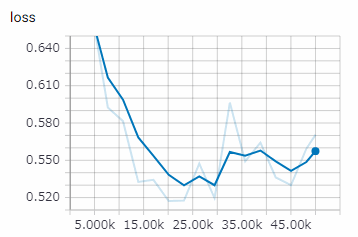
5,000ステップ
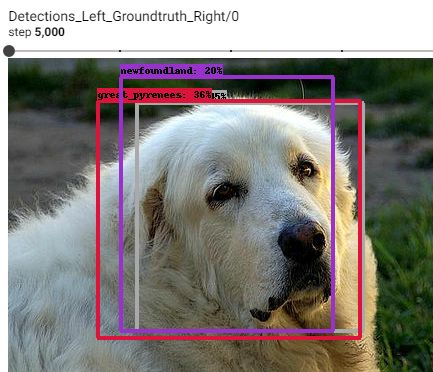
7,706ステップ
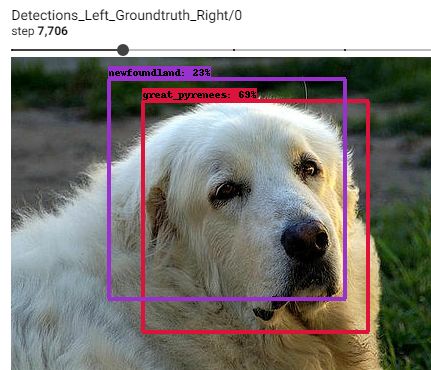
23,255ステップ
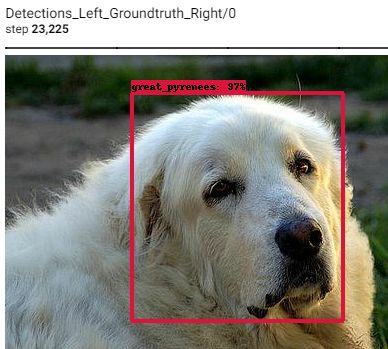
2万ステップぐらいで良いかも知れません。
10. Tensorflowグラフのエクスポート
モデルの訓練が終えたら、推論用にグラフをエキスポートします。
python object_detection/export_inference_graph.py \
--input_type image_tensor \
--pipeline_config_path /foo/pets/faster_rcnn_resnet101_pets.config \
--trained_checkpoint_prefix /foo/pets/model.ckpt-50000 \
--output_directory /foo/pets/exported_graphs
model.ckpt-50000の「50000」は各自が実際に実行したステップ数に変更してください。
11. 推論(モデルの実行)
models/research/object_detection/object_detection_tutorial.ipynbをダウンロードして名称をpets.ipynbに変更します。次にmodels/research/object_detection/pets.ipynbに移動します。
Jupyter NoteBookで「pets.ipynb」を起動します。
[Model preparation]
次の変数を変更します。
PATH_TO_FROZEN_GRAPH = '/foo/pets/exported_graphs/frozen_inference_graph.pb' PATH_TO_LABELS = '/foo/pets/pet_label_map.pbtxt' NUM_CLASSES = 37
[Download Model]
ダウンロードする必要がないので、このセルは全てコメントにします。
[Detection]
テストする画像を変更する場合は、PATH_TO_TEST_IMAGES_DIR、TEST_IMAGE_PATHSを変更します。
推論するには「上から順番にRunする」 or 「メニューのKernel - Restart & Run All」を実行します。
12. pets.ipynbの簡易的な解説
// 推論を実行する output_dict = run_inference_for_single_image() // Box (矩形範囲) output_dict['detection_boxes'], // Class(分類番号) output_dict['detection_classes'], // Score(スコア) output_dict['detection_scores'],
// 推論結果から画像の上にスコア、分類名を重ねる vis_util.visualize_boxes_and_labels_on_image_array() def visualize_boxes_and_labels_on_image_array( image, // イメージ boxes, // Box classes, // Class scores, // Score category_index, // カテゴリ辞書 instance_masks=None, instance_boundaries=None, keypoints=None, use_normalized_coordinates=False, max_boxes_to_draw=20,// 視覚化するボックスの最大数 min_score_thresh=.5, // 視覚化されるボックスの最小スコア閾値 agnostic_mode=False, // クラスに依存しないモードで評価する line_thickness=4, // ボックスの線幅 groundtruth_box_visualization_color='black', skip_scores=False, skip_labels=False):
min_score_threshはデフォルトでは「.5」(50%)になっているので、これを下げれば表示されるBoxが増加します。
visualize_boxes_and_labels_on_image_arrayの引数の詳細はvisualization_utils.pyをご覧ください。
13. 最後に
ここまで出来れば、後は「オリジナルのデータセット」を用意すれば顔認識、自動車認識、寿司認識やら任意の物体を検出可能です。
次回はオリジナルのデータセットで物体検出を行います。
参考URL
Running Locally (公式)
関連記事
| 前の記事: | 画像内の物体を検出するObject Detection APIの使用方法 [TensorFlow] |
| 次の記事: | 画像内の「カップラーメン」を検出する [Object Detection API] |
プチモンテ ※この記事を書いた人
 | |
 | 💻 ITスキル・経験 サーバー構築からWebアプリケーション開発。IoTをはじめとする電子工作、ロボット、人工知能やスマホ/OSアプリまで分野問わず経験。 画像処理/音声処理/アニメーション、3Dゲーム、会計ソフト、PDF作成/編集、逆アセンブラ、EXE/DLLファイルの書き換えなどのアプリを公開。詳しくは自己紹介へ |
| 🎵 音楽制作 BGMは楽器(音源)さえあれば、何でも制作可能。歌モノは主にロック、バラード、ポップスを制作。歌詞は抒情詩、抒情的な楽曲が多い。楽曲制作は🔰2023年12月中旬 ~ | |









